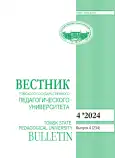№ 4 (2024)
ТЕОРЕТИЧЕСКАЯ И ПРИКЛАДНАЯ ЛИНГВИСТИКА
Модус времени как лингвистическое понятие: к вопросу о средствах языковой репрезентации в художественном тексте
Аннотация
 7-15
7-15


Коммуникативное поведение языковой личности автора и его дискурсивная обусловленность (на материале творчества В. В. Маяковского)
Аннотация
 16-23
16-23


О комплементе степени 可以 kěyǐ в современном китайском языке
Аннотация
 24-32
24-32


Переключение и смешение кодов как показатели современной двуязычной персидской коммуникации
Аннотация
В статье предпринимается попытка исследовать феномен переключения и смешения между персидским (Афганистан) и английским языками. Переключение языков описывает ситуацию, когда говорящий меняет язык внутри одной речевой ситуации. Это может происходить на уровне предложений, фраз или даже отдельных слов. При переключении языков говорящий переходит из одного языка в другой с целью коммуникативного удобства, выражения своей идентичности, обозначения социального статуса или принадлежности к определенной группе. Смешение языков отличается от переключения языков тем, что происходит смешение элементов разных языков внутри одного предложения или даже слова. Это может быть результатом языкового влияния, билингвального воспитания или желания говорящего выразить себя с помощью различных языковых ресурсов. Исследование сосредоточено на двух коммуникативных ситуациях. Первая коммуникативная ситуация представлена неформальным разговорным общением, другая относится к области художественной литературы. Для проведения исследования были собраны данные из группового чата с участием 30 студентов, изучающих английский язык и литературу на факультете английского языка Университета Балк в Афганистане. Группа была создана для неформального обсуждения академических и неакадемических вопросов. Сообщения, которыми обмениваются в этом групповом чате, служат примером для анализа неформального разговорного общения. Кроме того, в качестве примеров литературы были выбраны романы Халеда Хоссейни, американского писателя афганского происхождения, который свободно владеет персидским (Афганистан) и английским языками. Халед Хоссейни получил международное признание благодаря своим произведениям. В его работах описываются культурные и исторические реалии жизни в Афганистане, часто затрагиваются темы идентичности, семьи, любви, потерь и влияния политических потрясений на отдельных людей и общество. Исследование выполнено по специальности 5.9.8 «Теоретическая, прикладная и сравнительно-сопоставительная лингвистика (филологические науки)». Цель исследования – выявить причины и цели, стоящие за переключением и смешением языков в различных коммуникативных ситуациях. Анализ контекстов, в которых происходят такие языковые практики, позволяет определить мотивы коммуникантов.
 33-40
33-40


СОПОСТАВИТЕЛЬНАЯ ЛИНГВИСТИКА
Лингвокоммуникативная экспликация эмоций в англоязычных и испаноязычных интернет-комментариях на тему вакцинации от СOVID-19
Аннотация
 41-49
41-49


РУССКИЙ ЯЗЫК. ЯЗЫКИ НАРОДОВ РОССИИ
Способы референциального ранжирования субъектов в русских пословицах с формами второго лица единственного числа
Аннотация
 50-58
50-58


Концепт «творчество» и средства его воплощения в лирике Ю. Д. Левитанского
Аннотация
 59-67
59-67


Содержание концепта «творчество» и средства его вербализации в лирике Н. А. Заболоцкого разных лет
Аннотация
 68-74
68-74


РОМАНСКИЕ И ГЕРМАНСКИЕ ЯЗЫКИ
История зарождения английского языка как ключ к пониманию его текущего статуса
Аннотация
 75-83
75-83


Конфронтационные стратегии и тактики как средства репрезентации речевой агрессии в политической коммуникации (на материале выступления Олафа Шольца)
Аннотация
 84-92
84-92


МЕТОДИЧЕСКИЕ АСПЕКТЫ СОВРЕМЕННОЙ ФИЛОЛОГИИ
Опыт создания и реализации модели подготовки специалистов в области преподавания русского языка как иностранного в современном поликультурном пространстве (на примере деятельности Муданьцзянского педагогического университета)
Аннотация
 93-102
93-102


Фразеологическая картина мира обучающихся в системе среднего профессионального образования: лингвокогнитивное исследование
Аннотация
 103-110
103-110


РУССКАЯ ЛИТЕРАТУРА, ЛИТЕРАТУРЫ НАРОДОВ РОССИЙСКОЙ ФЕДЕРАЦИИ
Коранические мотивы как доминанта творческих поисков Д. П. Ознобишина
Аннотация
 111-119
111-119


Тема страха в творчестве А. П. Чехова 1880-х – начала 1890-х годов: типология авторской позиции
Аннотация
 120-127
120-127


Специфика художественного осмысления темы войны в рассказах Ю. Яковлева «Где стояла батарея» и «Иван-Виллис»
Аннотация
 128-135
128-135


Повесть Н. В. Гоголя «Шинель» в рецептивном сознании эпохи рубежа XX–XXI веков. Статья 1
Аннотация
 136-145
136-145


Художественное своеобразие пейзажной лирики детской литературы коми
Аннотация
 146-153
146-153


К 85-ЛЕТИЮ ПЕРВОГО ИЗДАНИЯ СКАЗКИ А. М. ВОЛКОВА «ВОЛШЕБНИК ИЗУМРУДНОГО ГОРОДА»
Рукописи А. М. Волкова как ключи к пониманию развития авторского замысла сказки «Волшебник Изумрудного города»
Аннотация
 154-168
154-168









